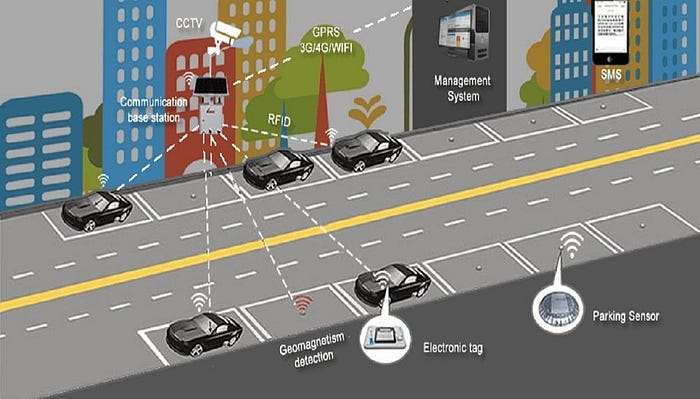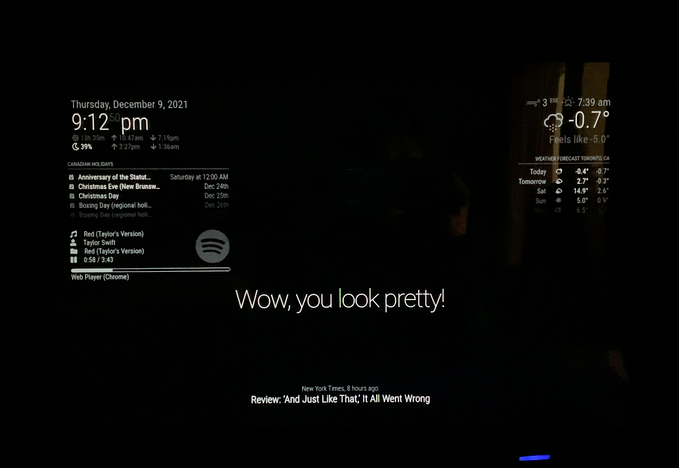A Utopian Future: Smart cities
What are smart cities? How do they work? And how does IoT play a role?
I have a question: what comes to mind when you think of “smart cities?”
Is it a dystopian fantasy with flying cars and teleportation? Or is a place run by robots? Does it seem like something in the distant future?
For me it did. It seemed like something so far-fetched, I wouldn’t be alive to see it happen. But like most things in life, I was wrong. Smart cities are very much a thing of the present.
So what are they?
Basically, a smart city uses technology to make the lives of residents better and improve their quality of life.
A smart city is made up of many different technologies (like AI), but a very important one is IoT.
Now, you may be wondering…
“Mansi, what is IoT?”
IoT stands for the Internet of Things. It’s a huge network with connected devices that share information with each other. It’s done using the help of sensors. Almost every piece of technology or device you come across has sensors that are constantly gathering information. IoT allows these devices to share their gathered information. On an IoT platform, the data is analyzed and extracted for important information, then sent to the other devices via the internet.

Let’s look at a simple example of IoT: A smart thermostat.
It works by sensing the air temperature and switching on the heating when the air temperature falls below the thermostat setting (which you input through your device) and switching it off once this set temperature has been reached. All that is then transmitted back to your device and from there, do what you wish with that data.
Brief Benefits
According to a study done by the McKinsey Global Institute, smart cities can improve the cost of living, safety, time, jobs, connectedness, environment, and health of residents by 30%.
So, how exactly can they do that? I was wondering the same thing. So I did some reading and here’s what I found:
Traffic:
Let’s be honest, traffic sucks. And being late because of traffic sucks even more! But you can say goodbye to all of that in a smart city. Public transport routes can automatically adjust in real-time according to the demand. IoT can alert residents to use public transit during off-hours and guide them through the city in real-time.
Example: Palo Alto
A small city in Silicon Valley has become a pioneer in smart city technology. They have come up with many solutions that use IoT to create an optimal city for their 67 000 residents.
To gather and share data, Palo Alto has many different types of sensor networks to do so on a large scale. The city is setting up a sensor network that will collect and share information about parking capacity all over downtown. Sensors will be used to give a real-time look into which parking spots are vacant in the downtown area and to count pedestrian and bicycle traffic along sidewalks. When a car pulls into a parking spot above a sensor, the metal will trigger the magnet. The magnet then “wakes up” the optical sensor, which confirms that there is a car in the spot. All of that then gets relayed back to resident’s phones/devices which allows them to get an idea of where parking is available before they leave for their destination.

Environmental:
Beyond just improving the day-to-day lives of its residents, smart cities harness the power to improve the long-term quality of life too. Often overlooked, smart cities can lower GHG emissions by 10–15%, 30–130 fewer kilograms of solid waste per person per year, and 25–80 litres of water saved per person per day.
- Sensors can track the amount of CO2 in the air and how much is being released. This can give the city an idea of how much pollution is happening and can give them an idea of how to combat it.
- Smart LED street lights. They last longer and require less energy to operate. They can also automatically adjust brightness levels during different times of day and weather conditions to ensure efficiency without compromising safety.
Dangerous Down Sides
In 2014, researchers from the University of Michigan hacked 100 traffic lights of the city’s intersections, proving security flaws existed that had the potential to cause serious accidents. In 2017, hackers turned on 156 severe weather sirens in Dallas in the middle of the night, causing a flood of 911 calls and panic.
As terrible as these studies sound, they were important in showing us the dark side of IoT; a lack of cyber security. One of the biggest downsides of IoT and smart cities is the security and privacy aspect. They are vulnerable to hacking and hijacking due to the nature of the technology. The root of the problem comes from the lack of encryption and patching over the wire.
Solutions
Biometrics:
Implementing biometric authentication processes for all cloud and end-point access will enhance the safety of the network. This means only select personnel will be able to access certain data. Biometrics could be in the form of fingerprint identification, iris scanning, etc.

Isolating endpoints:
Compartmentalizing each endpoint means that every device connected to the network will remain anonymous. Isolating endpoints can help contain viruses or limit hackers to a certain part of the network. Endpoint isolation is a technique used by cybersecurity solutions to separate computers or other endpoint devices from the rest of the network to prevent hacking.
So, I think I’ve been told a million times by now that we’re living in an exciting time with technology being at its peak. And I don’t think I really internalized it until I started writing this article. The idea of living in a city that can be so technologically advanced was unthinkable 30 years ago. Today, the frameworks have been implemented in over 50 countries around the world.
“The internet is no longer a web that we connect to. Instead, it’s a computerized networked and interconnected world that we live in. This is the future, and what we’re calling the Internet of Things.”







